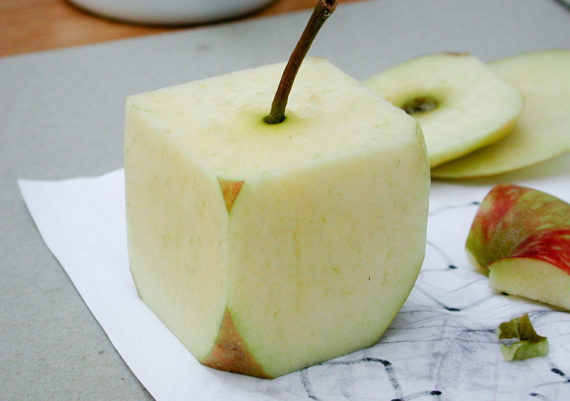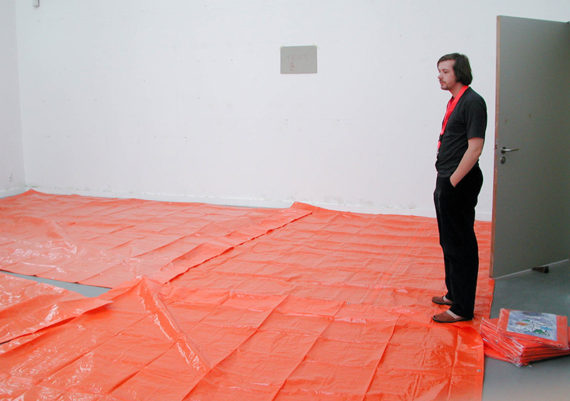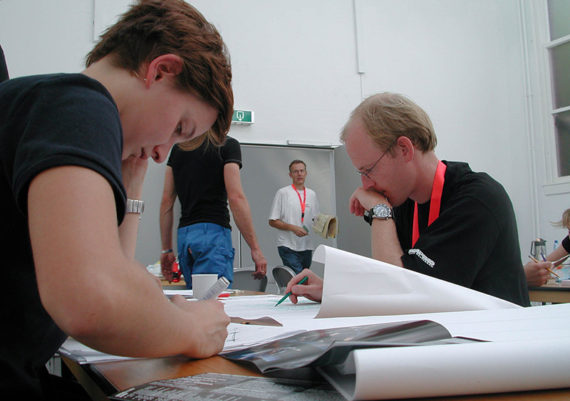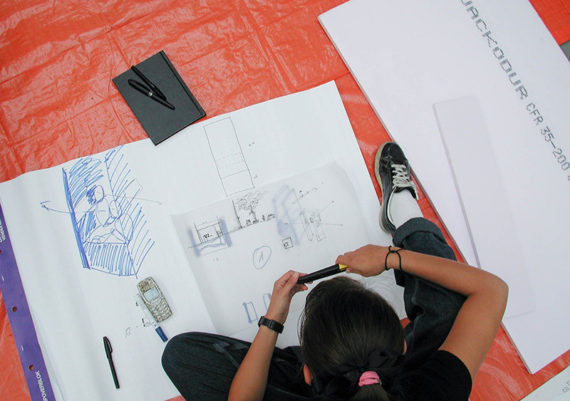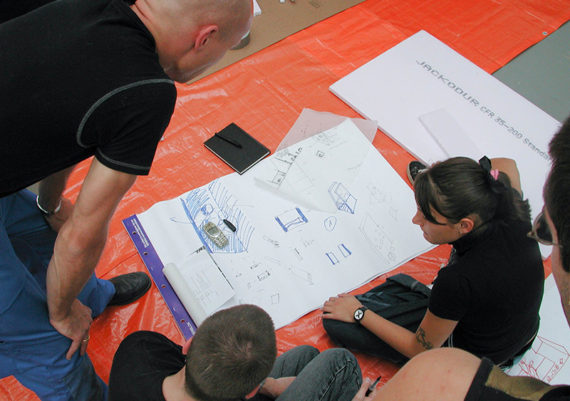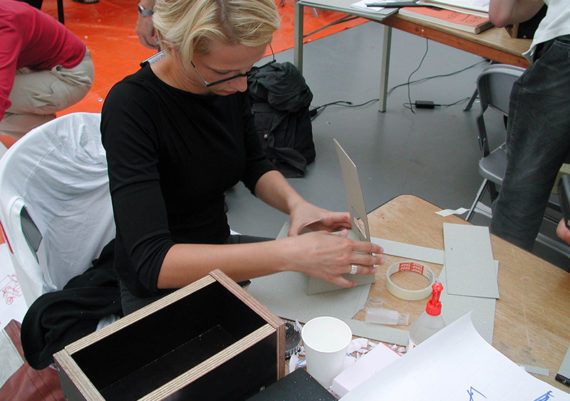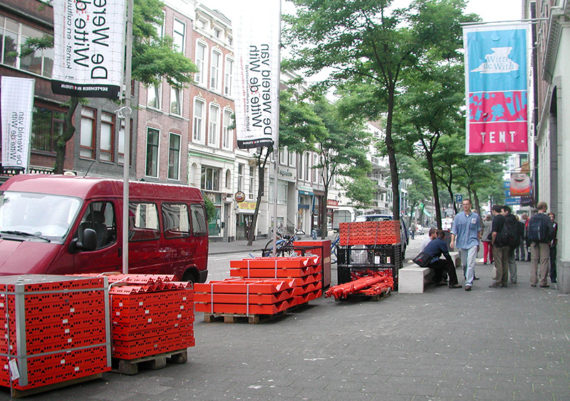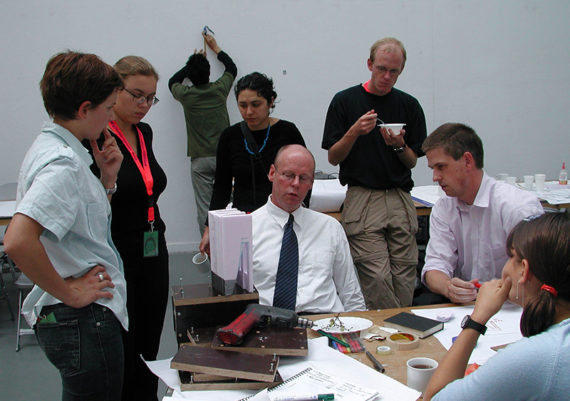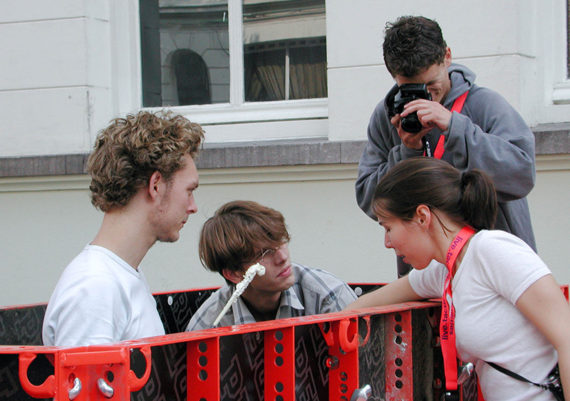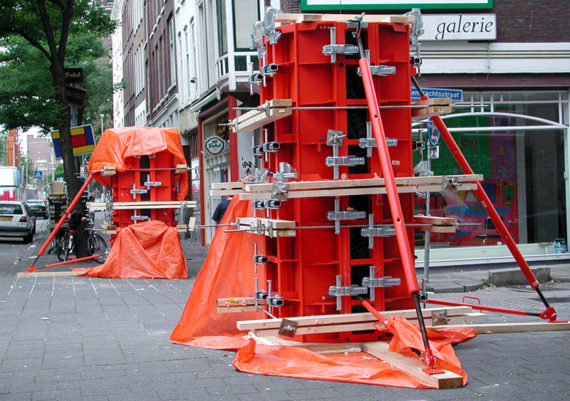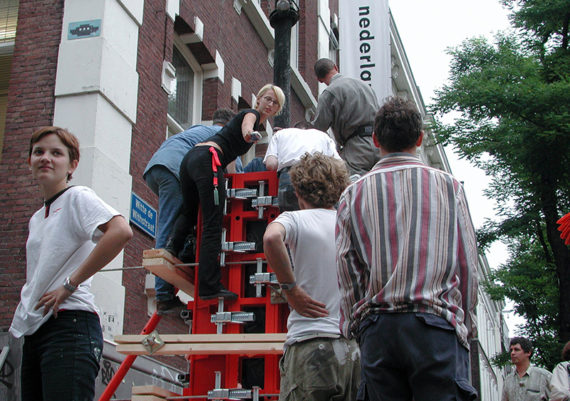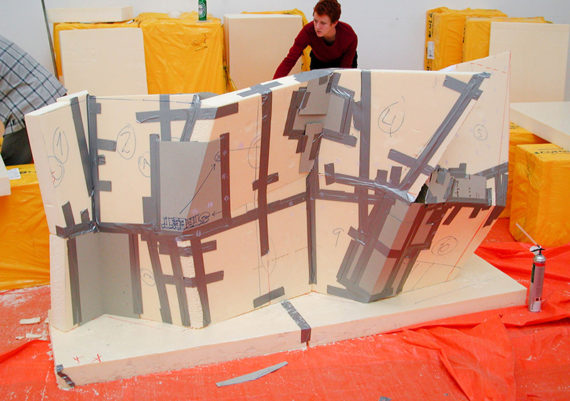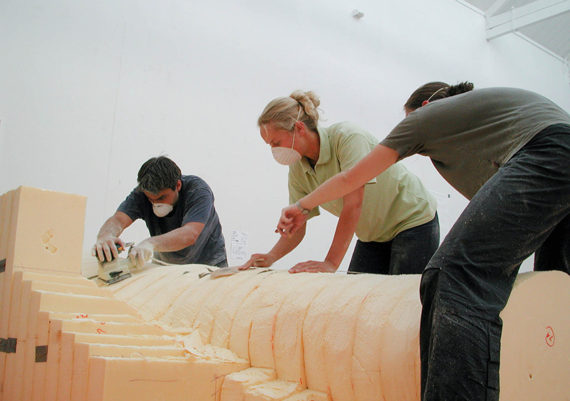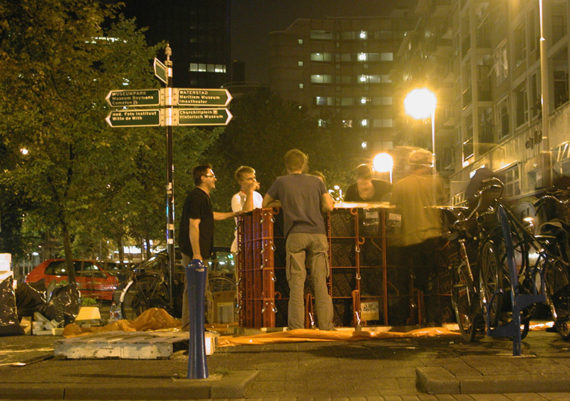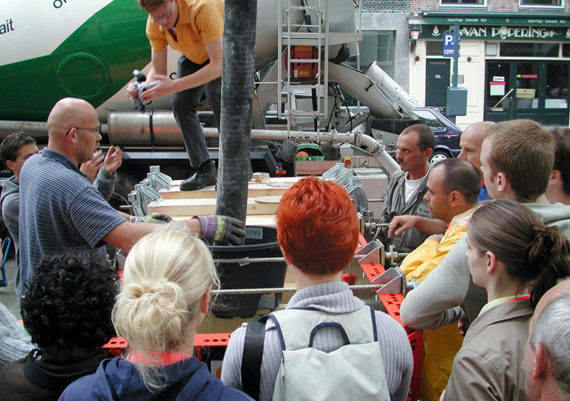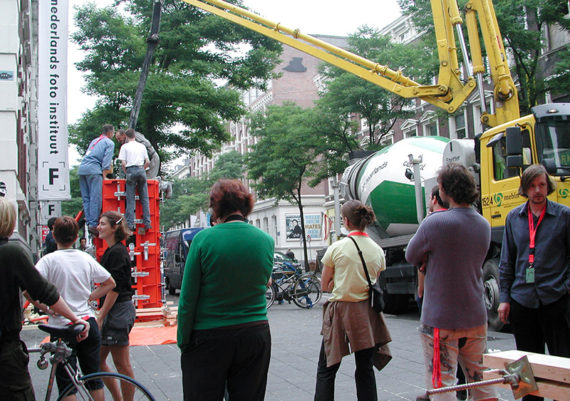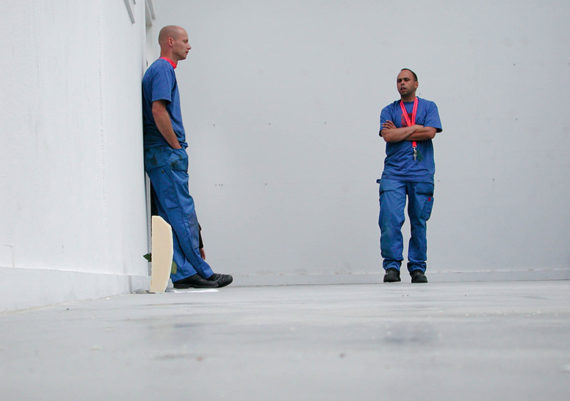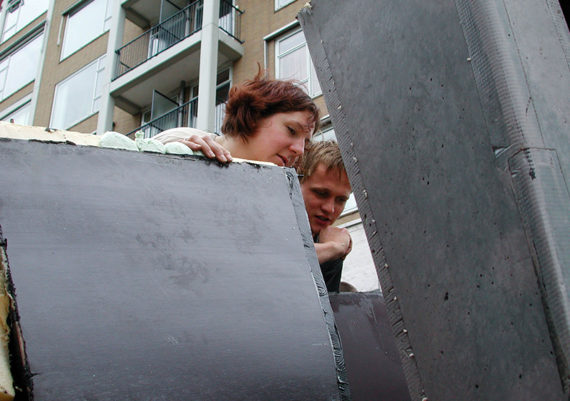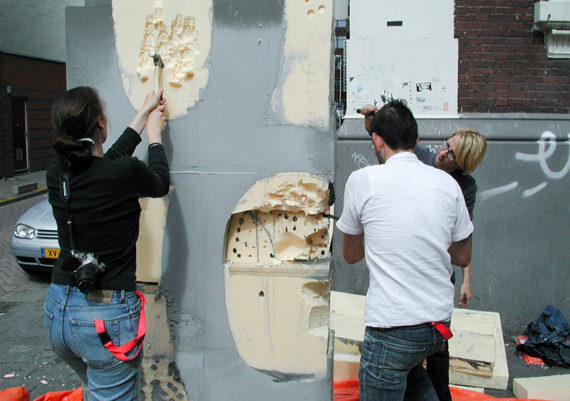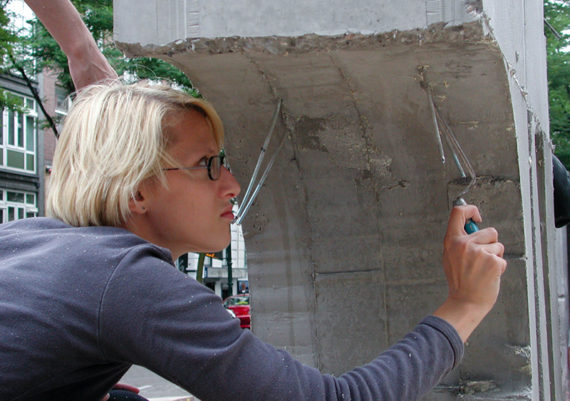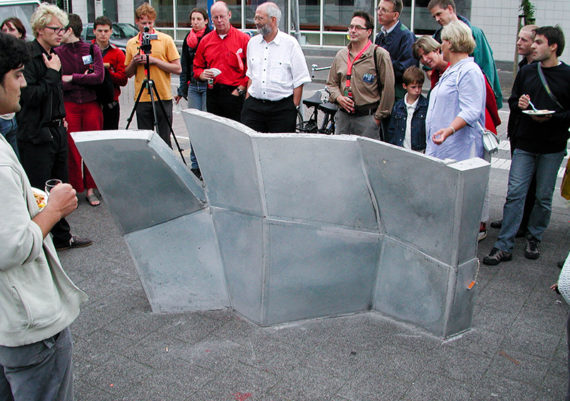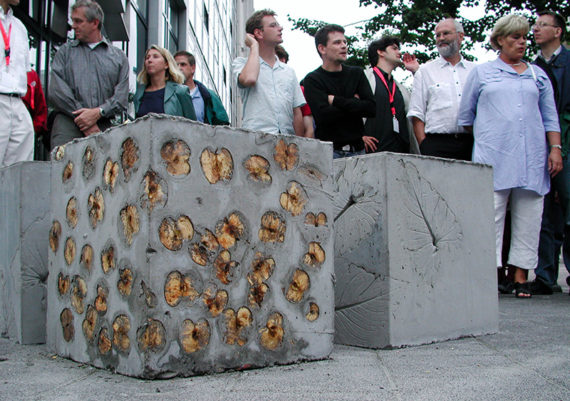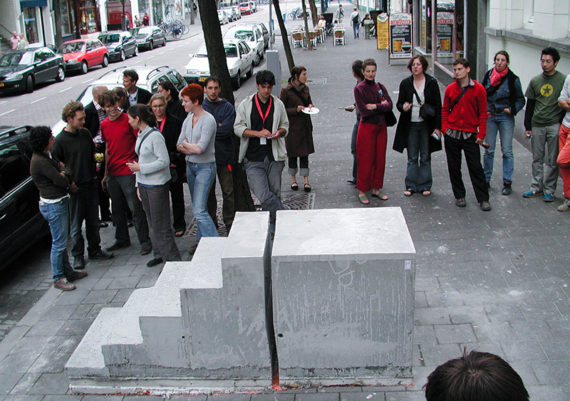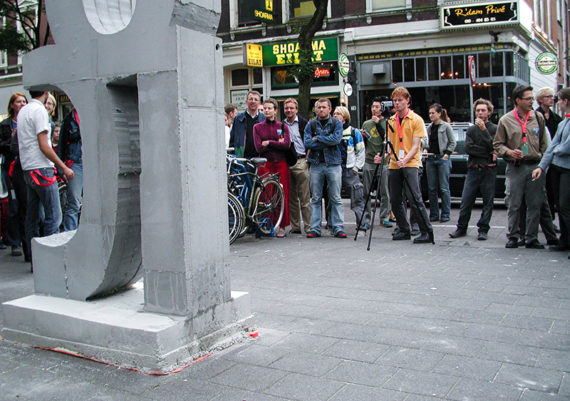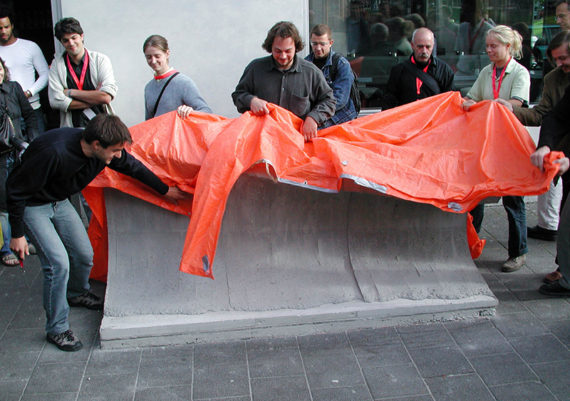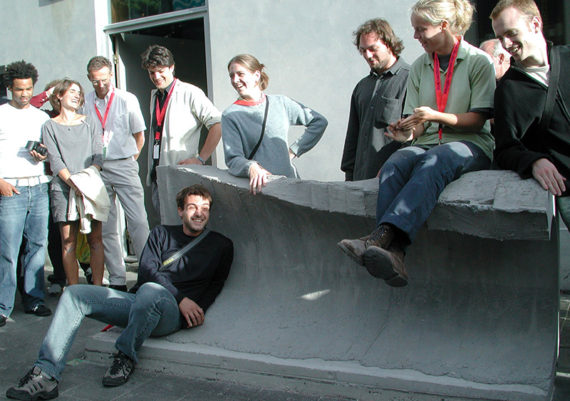Blitz Beton Workshop 2002 - Concrete Branding
Investigation of the branding capacities of architectural objects. Or how can architectural objects enhance identities and feelings of belonging for clients, passer-bys, the city and the objects themselves.
2002
concept, coordination & management, lecturing, publication
Concrete Branding
Documenting the Blitz Beton Workshop Concrete Branding. Rotterdam, August 2002
film
Okke van den Broek & Maarten Veerman
editing
Siebe Bakker
English / Dutch
assignment
Investigation of the branding capacities of architectural objects.
Or how can architectural objects enhance identities and feelings of belonging for clients, passer-bys, the city and the objects themselves.
Ideas will be tested in models and finally in scale 1:1 objects, both made out of concrete. The tactile characteristics of the designs and how these influences the branding capacities will be the main focus besides of course formal, functional and contextual aspects.
Branding operates on at least four levels. At the level of externals; shops, manufacturers, institutions, ideals, etc. At the level of the process, the making of, the experience, the context. At the level of the object concerning the temporary, material, tactility and form. And also at the level of the (end)user; giving stature to the passers-by, exhibiting the accidental engagement, facilitating unforeseen desires. It is not unlikely that there will be many more levels at which one can interpret and exploit the notion of branding. Thomas Gad (copywriter / creative director / brand strategist) identifies in his book 4-D branding 4 other partially overlapping and highly relevant dimensions of branding; the functional dimension concerns the perception of benefit of the product or service associated with the brand; the social dimension concerns the ability to create identification with a group; the spiritual dimension is the perception of global or local responsibility; the mental dimension is the ability to support the individual mentally.
Ideas are to be tested in several objects. These objects are placed in the public realm – Witte de Withstraat. At first sight they might appear as mere street-furniture, signs or sculptures. However their main purpose is to give meaning and place to notions of branding, as well as a series and as individuals. Obvious associations are of course: concrete, Rotterdam, TENT., Witte de Withstraat and ENCI. Fascinations of participants will finally limit the scope of investigation.
The first ideas
All participant were asked to present their first ideas, associations and fascinations concerning Concrete Branding. To start a discussion that will cover any line of thought, from pure theoretical, to political and more practical matters, these entries were used and abused (?)in a way that does credit to branding. The discussions took place as preparation for the workshop on a webbased forum during the months preceding our week in Rotterdam. The notions were grouped in five themes; COMMERCIAL, OPPORTUNISTIC, POETIC, URBAN and PRAGMATIC. Each running a suitable subtitle. Of course any entry could have been placed under any ‘box’. And some might be obviously misplaced. However, this inventory was used to explain, add, defend, fight and question any ideas that will help understanding the realm of branding with/by/in/for/through architecture.
COMMERCIAL - MacDonalds vs The Temples
Many of you have been dazzled by McDonalds. Its apparent architectural presence in our society seems overwhelming. The ability to make impressions with either spectacular buildings or with an almost military repetition of stylistic elements – either cheap and easy or exclusive and elaborate – is understood. But how do ‘Be Different!’ (Nandor) and ‘The building brand of McDonalds found its way into a standardization of parts which, when employed systematically, provided an economic recognizable building type’ (Marieke) relate to each other? Are they both true? Are they really different from each other?
Some questions you raised yourselves:
’My opinion on the other hand is that for the architecture this (McDonalds) way of dealing with the “branding of/with architecture” is a little too simple and poor’ (Marieke) Too simple and poor? Or is it actually just very straightforward and effective? Many raised similar questions of what architecture should be. ‘Shouldn’t the architecture play a more important role in this kind of commercial activities?’ (Koosjan). What role could be more important? ‘Architecture can and should be a tool of marketing, a useless beauty covering the utility designed to impress people.’ (Martha) AND ‘Architecture should function as a marketing tool because otherwise the architect loses control of how the building is going to look like.’ (Femke)
‘Are we ever getting tired of these branding architecture with a bombing of images?’ [concerning Disneyworld] (Vincenth). ‘I think branding in architecture hasn’t been exploited in its full potential yet and certainly not by architects, who are the only ones that could save this type of ‘branding’ from becoming a standard recipe.’(Denisa) So, in the ING bank, what is more important, the image (form, color, etc.) of the building or the way people can use it and how they feel in it? And which of the two exploits the ‘branding capacities of architecture’ best? ‘When [does] the cities’ desire to be recognized push the potential of architecture as a marketing tool to its limits?’(Daan) AND ‘When [does] logo branding become building branding?’ (Daan)
Mads’ piece on the Eames House seems a compelling plea for architectural experiment in order to brand our own profession. But more interesting it combines ideas on branding with a notion of evolution! ‘A desire to be creative and innovative which is a must when you will brand with architecture.’(Mads)
Mirko shows a shortlist of architectural means by which branding can be exploited; structure, color, transparency and quality. Quality?
And finally: ‘Architecture used for marketing purposes becomes a merchandise itself while it tends to forget about its most important factor – MAN’ (Simko)
Can you relate to all this? Can you answer the questions? If you can, you can also put these notions to use!
OPPORTUNISTIC - Me, The DESIGNER
Some of you took the opportunity to just present themselves as designers, so it seems. At first sight there appears no understandable connection to the theme or the idea of branding. Or perhaps these entries are the most direct and confrontational examples of the branding capacities of architecture. As stated by someone else – ‘Architects and designers use the media to their advantage to publicize their work instead of the other way around’ (Daan / COMMERCIAL) – and even more explicit: ‘… Architects have to make a signature to exist’ (Lacin Karaoz).
Anyway, I hereby dare Ben, Robert, Marek, Olmo and Beata to elaborate on their entries. Is it possible for you to clarify what the connections are between your entries and the theme? Or where there might be overlaps?
POETIC - Fascinations and Ambitions
Eva, Dennis, Hans Christiaan, Markus, Arjan, Michel and Ivo have exploited a strong aspect of branding. No immediate and clear relation to the theme is expressed in terms of solutions or focus points. No clear statement is made. However, all entries, texts, images and ‘designs’ leave a unmistakable feeling of direction and ambition. Branding as aura.
‘We need a lot. But does life need architectural design?’ (Ivo) ‘Concrete can be seen as a monument of our times. It holds within it a past, yet preserves a future.’ (Hans Christiaan) ‘When this unique signature transforms into brand, it becomes common and exactly this is what makes design ordinary.’ (Lacin) ‘Architecture must show its face as it is and gather age in dignity’ (Dennis) ‘It’s about the transformation of sand hills by running concrete that flows ….’ (Eva)
So how can we take all this one step back? It is great to have results, however it would be even better to know how to control these evoking statements. How does it work? How can you master the outcome of poetic input?
URBAN - Image and Experience
(Michiel & Maira) ‘Because some cities already have become a brand, other cities start to copy the sceneries associated with the ‘brand’.’ … As a result of this, cities or at least parts of them are soulless. You might copy the look, you can’t copy the feel that easily.’ … ‘In order to become a solid brand, cities should show their true face(s).’ … ‘The city is no Disneyland!’ …
Since our workshop will operate in the city, it is of great importance to grasp the possibilities this setting offers. Michiel’s and Maira’s text for sure raises some aspects. However, can you also answer your own questions? How do you investigate the true faces of a city? Are there any? Or are there many? It is obvious that it is difficult to copy a feeling, but is it possible at all. Does architecture and urbanism not always induce feelings? How can you control these? Is branding just another word for evoking?
PRAGMATIC - Materiality and Process
The use of concrete in 1:1 objects forms the central part in this workshop, it is definitively of great importance to investigate the influences and opportunities of techniques and building- / design processes on the branding capacities of the objects. Victoria and Anna state in their entry: ‘There has been an evolution of the use of materials from being a simple means of construction in to a genuine means of architectural expression.’ Ida mentions: ‘Now it [material/concrete] can even become a brand sign of a textile company, a grocery. And maybe by these new means [coloring / photographic ‘etching’] it won’t be defined as a rigid and ugly something that can only be hated.’
Some questions. Does the ability to form and transform the surfaces of materials really influence the architectural expression or experience so much? Is there any difference between the concrete surface wallpaper (Anna & Victoria) and the application of traditional ‘real’ wallpaper? And can you explain this? Can the understanding of architecture be reduced to its 2D image? Or is the influence of weight and thickness of similar importance and perhaps correspondingly changing with the evolution of techniques? Is an experience of architecture captured by its image, 2D or 3D? Or is there more to consider? And finally, for the moment, lets consider how branding does relate to experience (see also Michiel & Maira), the materials, how they are used and - especially for this workshop – how a group of about 36 different designers can collaborate in this process.
experience: a steaming pressure coocker
‘A steaming pressure cooker’. That’s a fitting description of the fifth Blitz Beton Workshop in which thirty students of architecture from all over Europe made objects in concrete. After a week of intensive discussions, sketching, model-making and finally preparing and filling moulds, six concrete objects, each weighing about 2000 kg, were placed along Witte de Withstraat in Rotterdam.
The workshop was the fifth and last in a series initiated by cement producer ENCI, intended to generate collaboration among students designing in and with concrete. Thanks to earlier experiences, events went smoothly this year. The necessary materials where in ample supply, as were experienced technical specialists. What’s more, the workshop supervisors, Siebe Bakker and Henk Ovink, knew exactly when to put pressure on participants and when some gentle encouragement was needed. Deadlines were met with maximum results. And the venue was excellent. For a second time the workshop took place in the Centre for Visual Arts, TENT, where one of the exhibition halls became a temporary atelier. The activities there and elsewhere in the building formed an integral part of the programme at TENT.
The workshop started at midday on Sunday August 25. After an elaborate lunch the group warmed up with a brainstorm session led by creative consultants Dré Kampfraath and Nico Smak on the theme of ‘Concrete Branding’. After a group session to discuss ideas, participants had to ‘brand’ themselves using a white T-shirt and some markers. Soon everyone was dressed in logos and sound bites. Next there was an individual task. Students had to ‘brand’ an everyday item found in the home: an apple.
Hardly recovered from this rapid-fire start, participants enjoyed a lecture by Siebe Bakker in which he explored everything from concrete, fashion and Monaco to the Casa Malaparte. Participants were left with plenty to think about.
The next few days were a race against the clock to transform the broad theme of ‘Concrete Branding’ into six good and easy-to-build designs. To guarantee a sound start, participants divided themselves into groups of five or six individuals, each of which was committed to one location along Witte de Withstraat. The six locations were connected to six venues: Bar P, Scapino Ballet, V2 multimedia institute, an art gallery, a flower shop, and TENT. Each group had to brand one of these venues with a cubic metre of concrete restricted only by a mould measuring 0.9 by 1.2 by 2.4 metres. The moulds were positioned differently for every location.
Lively discussion soon started and sketches and models produced. Small moulds (scale 1:10) were available on Monday. Mortar models could be made using a rapid-hardening plaster. By pouring concrete into moulds and then removing the moulds, participants quickly came to appreciate the many possibilities and restrictions of concrete.
Many exciting ideas quickly became 3D. It was a difficult task to decide which idea to proceed with. Maarten Veerman and myself, assigned to film and photograph the workshop, were asked many times to assist in the process. Disputes as to the nature of collaborations occasionally arose of course.
After all designs had been refined, everyone got down to the hard job of making moulds from insulating foam, to be ready for pouring by Thursday evening. A scheduled night off was cancelled, to the disappointment of foreign participants in particular, who had hoped to see more of Rotterdam. But with working days from 9 a.m. to 11 p.m., there was just one night on the town. The other evenings were limited to drinking in Bar P and other Dutch student retreats. The cultural mix and intensive collaboration ensured a well-knit group, clearly illustrated on Friday when everyone was on hand to prevent a disaster when one of the moulds gave way.
The first two moulds were easily filled with self-compacting concrete. The third, in front of TENT, caused a problem. The enormous pressure created by a 1-metre-depth of fluid concrete caused the mould to break. A cubic metre of concrete leaked from the mould almost as fast as it was filled. A thick stream of grey oozed across the pavement, onto the roadway and almost into the city drainage system.
‘Block the drains!’ shouted one of the co-ordinators. It was all hands on deck as everyone tried to avert disaster with cartons and sandbags. The organisers thought it was all over, but some responded pragmatically. The mould was put together again and reinforced. Scooped-up in buckets, the concrete could be reused. The other moulds where filled in phases, starting with a shallow bottom layer and topped off later that afternoon with a fresh supply of concrete courtesy of supplier Mebin, who was stretching its normal working hours. Thanks to this extraordinary effort, all six objects were successfully finished.
The last Saturday was reserved for removing the objects, which was a hell of a job because of the complex forms. The remaining time was spent preparing a presentation in TENT to mark the official end to the workshop. This consisted of presentations of the objects and some delightful snacks. The unofficial ending was, of course, a great party and night tour of Rotterdam. And then the final goodbyes were said. The objects were exhibited for three weeks, but the memories of an extraordinary week will live on for much longer.
Okke van den Broek
Previously published in B-nieuws
blitz beton - the ultimate concrete experience
Blitz Beton – the ultimate concrete experience
Architecture needs materials.
Architects need expertise.
Students need experience.
Materials need industry.
Industry needs customers.
Clients need architecture.
To meet all these needs, concrete companies created Blitz Beton.
Learning to appreciate concrete as an architectural material of great potential has been the aim of the Blitz Beton Workshop series. A full week of learning through action, of high speed and high pressure in an inspiring and enjoyable atmosphere. Working in an international group with professional facilities and expertise. A temporary concrete result and an enduring memory of concrete. The workshop is also a unique experience: learning to think with your hands and feel with your mind. For understanding materials is not a matter of books. Materials must be touched, smelled and tasted.
ENCI, the Netherlands Cement Industry, has spearheaded the Blitz Beton programme for concrete learning experiences. As Dutch market leader in cement and concrete, we have a responsibility to foster the education of future architects and structural engineers. In collaboration with other companies, ENCI wants to be a partner and facilitator for educational institutes.
The Blitz Beton network numbers 25 supporting companies that have assisted the workshops by providing a wide range of materials and experts, from concrete mortar to structural consultants. The companies that supported this year's workshop are listed in the colophon.
Our role as facilitators opens up attractive possibilities for schools for architecture by enabling students to make full-scale objects. Though the concrete industry offers schools this opportunity, our aim is not to influence education itself. That is why we asked an independent organisation, bureaubakker, to take responsibility for all educational aspects of the workshops.
Every year we focused on a particular type of concrete.
The first Blitz Beton Workshop, in 1998, supervised by Peter Wilson, focused on prefabricated concrete.
In the second workshop, supervised by Zvi Hecker, we cast a very new product called self-compacting concrete on site.
In the third workshop we worked with lightweight, foamed concrete, which could be modelled with hand-held tools. Japanese star architect Jun Aoki was the supervisor.
In the fourth workshop we concentrated on sprayed concrete, or ‘shotcrete’. This allowed us to go beyond the restrictions of formwork with rectangular shapes. Four Belgian architects supervised the design process.
And this year, for the fifth and final workshop, we returned to on-site casting with a sophisticated type of mortar: fibre-reinforced, self-compacting concrete. Supervision and co-ordination was in the hands of Siebe Bakker, who was assisted by numerous experts in the fields of architecture, art and marketing.
We asked participants to design and make six architectural objects with 'Concrete Branding' as theme. The objects were to enhance different points along Witte de Withstraat, a bustling street in the centre of Rotterdam. To make this possible, we provided six boxes (each measuring 2.40 x 1.20 x 0.90 m) filled with polystyrene, a flexible moulding material.
The exercise ended with six completely different objects. Some were conceptual, some organic, some deconstructive. They were gifts to the public, temporary attractions with cultural potential.
The Blitz Beton Workshop 2002 was a unique learning experience. Students had to deal with the possibilities and limitations of concrete mortar, a building material that can be moulded. In just one week they learned more about concrete than they had in years of schooling. I have great admiration for the participants and their eagerness to take this opportunity to design and build in architectural concrete, to learn about and deal with the material’s nature and to understand how it to use it. I want to compliment all participants for their dedication and perseverance.
I also want to thank my colleagues from the cement industries in the United Kingdom, Germany, Belgium, Poland and Turkey, who kindly sponsored the participation of students from their countries. With these colleagues and with the support of the European association of cement industries – Cembureau – we are working on a sequel: a European design competition. The winners will receive a surprising learning experience. For concrete needs adventurous and creative students who can explore the material’s possibilities.
Hans Köhne
Mirko Bergmann, Maira Bos, Ivo van Cappelleveen, Marek Czyborra, Ben Dratz, Marieke van den Dungen, Mads Honoré, Severa Horner, Femke Kamp, Laçin Karaoz, Hans-Kristian Karlberg, Ida Kiss, Jean-Paul Koning, Dennis Lagemann, Marie Lang, Denisa Luijkx, Joanna Mazurek, Jean Menten, Hideo Nakayasu, Jakob Olmo Ahlmann, Martha Pieczara, Eva Pils, Michiel Raats, Victoria Rothschild, Arjan van Ruyven, Vincenth Schreurs, Gábor Simkó, Nandor Szabo-Petanac, Daan van Tassel, Anna Usborne, Koosjan van der Velden, Michel van der Velden, Nikkie van de Ven and Wietse
tutors
Siebe Bakker, Henk Ovink
experts & critics
Gert Anninga, Sarah Gaventa, Fred Gladdines, Rob Hoogenboom, Dré Kampfraath, Paul Lagendijk, Ton Simons, Niko Smak, Hanneke van Wel, Joanna van der Zanden
support
Hans Köhne, Niko Fitsky, Okke van den Broek, Maarten Veerman
supporting companies
Beamix, PERI Formwork Systems, Mebin Rotterdam, Plakabeton, Pont/Meyer, Strukton Betonbouw, Schauman, Van Noordenne
special thanks to
Arthur Bernard Studio, Bar P, Brutto Gusto, Marketing Rotterdam, Scapino Ballet, September Festival Rotterdam, V2,
host
TENT. Centrum Beeldende Kunst Rotterdam - Ove Lucas, Arno van Roosmalen
initiative
ENCI - Hans Köhne




